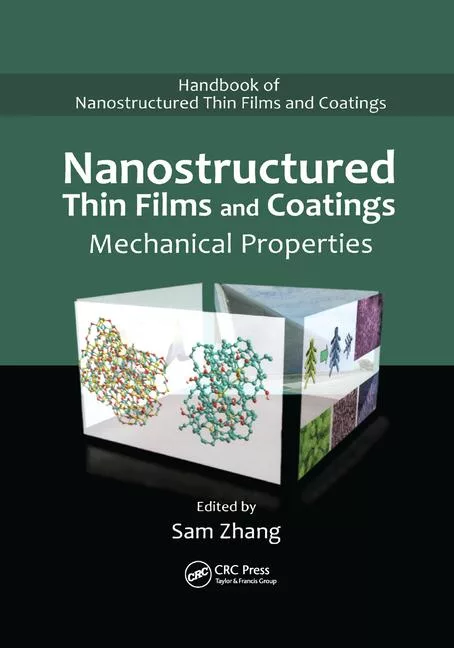Fast-Cure, Flexible and EHS-Friendly Epoxy Coatings
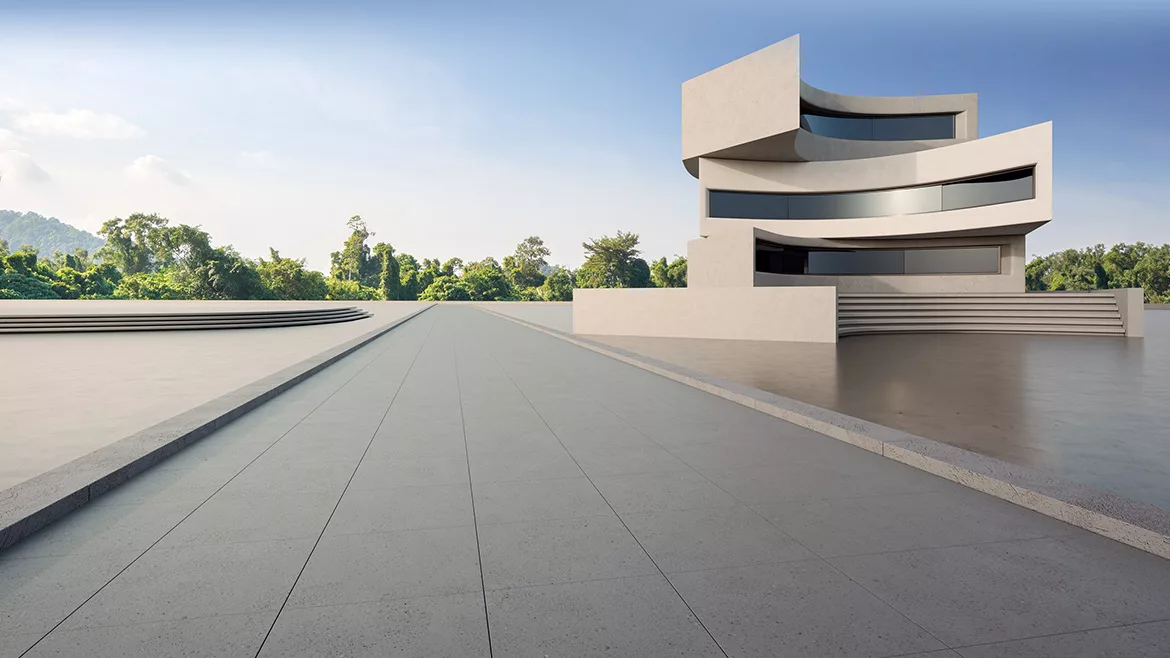
Flexible polymeric systems are widely used in industrial settings, including protective coatings, construction materials and adhesives. Protective coatings safeguard against wear and chemical attacks in applications such as tank linings, flooring and waterproofing membranes, applicable to various substrates like metal and concrete. In construction materials, flexibility is essential for applications such as joint sealants and crack bridging for concrete floors. Each application has specific flexibility requirements, ranging from 30% to over 100% elongation. However, common market trends and drivers for all applications focus on improved efficiency, enhanced performance and environmentally friendly products that meet Environmental, Health and Safety (EHS) standards.
Efficiency improvements center on fast curing to minimize downtime, greater substrate tolerance to reduce surface preparation time, and low-temperature curing to extend the application window. In terms of performance, long-term flexibility is desirable. EHS- and user-friendly products do not contain substances of high concern, feature low-to-zero VOCs and have low emissions, making them attractive to applicators and property owners. Additionally, incorporating renewable raw materials in these products enhances sustainability.
When selecting a flexible material, polyurethane is often the preferred choice due to its inherent flexibility.¹ Other flexible two-component (2K) thermosets include 2K polyurea. Epoxy systems, on the other hand, are not typically associated with flexibility. Instead, 2K epoxy systems are well known for their excellent mechanical properties, chemical resistance and adhesion to substrates. They are widely used as adhesives and protective coatings for concrete, metal and wood surfaces. Table 1 outlines the key flexible materials compared to standard and flexible epoxy. The limitations of flexible polyurethane and polyurea include handling of isocyanates, moisture sensitivity and the inability to apply thick coatings in a single pass. Their moisture sensitivity restricts application to dry substrates such as concrete.
Although 2K epoxy systems typically have limited flexibility, there are approaches to improve this property. These systems are thermoset polymer networks formed by the crosslinking of epoxy resins and curing agents, also known as hardeners.² The properties of these systems depend on both the resin and curing agent. Flexibility can be enhanced from both the epoxy resin and curing agent. Commercially available epoxy resins are generally limited to bisphenol A, bisphenol F and novolac.³ Adding functionalized, flexible, high-viscosity polyurethane modifiers to the epoxy resin can increase flexibility while maintaining strength and modulus. Alternatively, reactive diluents can improve flexibility but may reduce strength.
Curing agents are typically based on amine chemistry, offering a wide range of options to optimize an epoxy system. Long-chain alkylphenols, such as nonylphenol, have traditionally been used to increase flexibility from the curing agent side. However, nonylphenol is a reproductive toxin and has been phased out in many parts of the world. Since the curing agent plays a critical role in defining the cured epoxy network, emphasis has been placed on designing curing agents to tailor cure speed and overall system performance. This provides formulators with a toolbox to meet performance targets and EHS requirements. Table 1 outlines the key 2K flexible materials versus standard and flexible epoxy systems.
There is a clear market demand for a fast-cure, highly flexible and EHS-friendly epoxy system. Upon reviewing currently available flexible systems, it is evident that none fully address this unmet market need, as shown in Table 2. This paper introduces two new innovative curing agents that bridge both performance and EHS gaps in existing systems. These curing agents are specifically designed to offer high flexibility and high strength while enhancing the EHS profile.
Examining the chemical structures, flexible materials such as polyurethanes are made flexible and tough due to their unique structure of hard and soft segments. As illustrated in Figure 1, the soft segments provide flexibility, while the hard segments contribute to strength. Additionally, hydrogen bonding between the hard segments of polymer chains acts as noncovalent crosslinking, enhancing the strength of the polymer.

A similar design principle can be applied to a polyamide epoxy curing agent, where flexibility can be partially derived from the polyamine, and intermolecular hydrogen bonding provides additional strength, as illustrated in Figure 2. The flexibility of the curing agents is also attributed to the dimer acid, a dicarboxylic acid with a long alkyl chain as the R1 group in Figure 2. Dimer acid is derived from the dimerized fatty acid obtained from bio-based tall oil, making the curing agent a more sustainable solution.
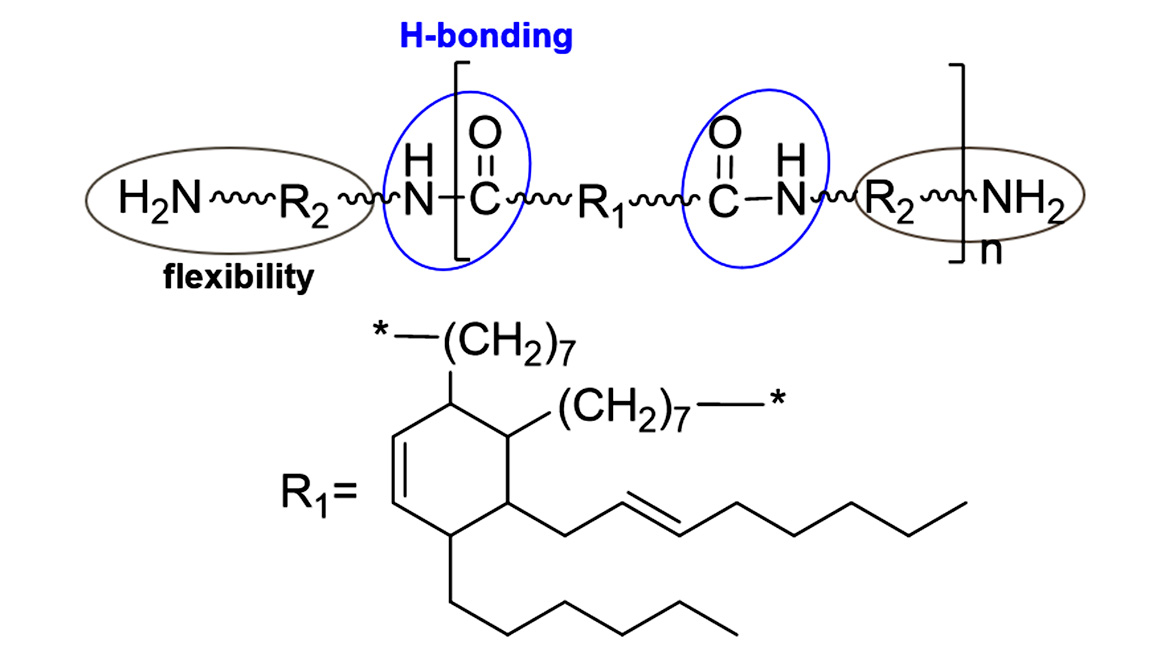
This paper introduces two new innovative curing agents, FCA-1 and FCA-2,4 that bridge both performance and EHS gaps in the existing systems. These curing agents are specifically designed to offer high flexibility and high strength while enhancing the EHS profile without the need for polyurethane modifiers. They also offer high tensile and tear strength, making them ideal for applications requiring flexibility, toughness and rapid return to service. Furthermore, these new curing agents do not contain substances of high concern, such as nonylphenol, making them an excellent choice for applications where improved EHS labeling is desired. The high percentage of bio-based raw materials and a bio-content of 20%-40% enhances their sustainability and eco-friendliness.
Experimental
New flexible curing agents, FCA-1 and FCA-2, have been developed using a proprietary amine technology. All coatings or castings were prepared with standard bisphenol A epoxy resin diluted with a glycidyl ether of C12-14 alcohol⁵ at the specified stoichiometry. The curing agent and resin were mixed using a speed mixer for one minute at 3,500 rpm. All test methods used in this paper are detailed in Table 3.
The cure speed, characterized as thin film set time (TFST), was evaluated according to ASTM D5895. A coating was drawn down at 6-mil wet film thickness on a 1-inch × 12-inch glass substrate and placed on a Beck-Koller recorder. The test was conducted at a specific scale of travel time under the designated environmental conditions.
The viscosity profiles were generated using a Brookfield viscometer at 25 °C with approximately 20 grams of mixed material. Gel time for a 150-gram mixture of epoxy resin and curing agent was recorded using a Techne GT-3 Gelation Timer. This was determined as the point when the product components gelled sufficiently to stop the free movement of the disposable plunger, which was operated at one cycle per minute.
Shore D hardness was performed according to ASTM D2240. A sample of approximately 35 grams of epoxy resin and curing agent mixture was poured into a 2.75-inch-diameter circular metal lid to obtain a 0.4-inch-thick clear cast.
Intercoat adhesion testing was conducted using two methods described in ASTM D3359: Method A (X-cut) and Method B (Cross-cut). The newly developed flexible epoxy was used as a primer and applied to a steel substrate, followed by the application of a topcoat after a specified time. The topcoats were cured under ambient conditions for 7 days before testing. The adhesion test results were rated according to the scale provided in the ASTM standard. For the X-cut method, results were noted on a scale of 0A-5A, with 5A being the best, showing no peeling or removal of coatings. For the cross-cut method, the rating was based on a scale of 0B-5B, with 5B being the best, indicating that the edges of the cuts were completely smooth and none of the squares of the lattice were detached.
Concrete adhesion was tested in accordance with ASTM D7234. A 1.5-inch-thick concrete block was sandblasted to a concrete surface profile of CSP 2 or CSP 3 prior to applying the epoxy coating at approximately 6 mils wet film thickness. The coatings were cured for 7 days under the specified environmental conditions before conducting the dolly pull-off test using a portable adhesion tester. The adhesion strength and mode of failure were documented.
Differential scanning calorimetry (DSC) was used to determine the degree of cure and glass transition temperature (Tg). A sample of approximately 5-10 mg from the designated stoichiometric mixture of epoxy resin and curing agent was analyzed using a TA Instruments DSC Q20 at a heating rate of 10 °C per minute. The sample was heated from -50 °C to 250 °C, cooled back to -50 °C, and the test was repeated.
Mechanical properties were tested according to the respective ASTM methods. A mixture of resin and curing agent at the specified stoichiometric ratio was cast and cured for 7 days at ambient conditions before testing. Tensile properties were evaluated based on ASTM D638 Type IV using an Instron machine to grip and pull the specimen at a crosshead speed of 2 inches per minute until failure. Tear strength was tested by two methods using an Instron machine: Die-C tear initiation per ASTM D624C and trouser tear propagation according to ASTM D1938, both at a crosshead speed of 20 inches per minute. Coatings for impact resistance and conical mandrel bend tests were applied to cold-rolled steel at a wet film thickness of 6 mils and cured at ambient temperature and 50% RH for 7 days before testing.
Results and Discussion
Handling Properties
The new flexible curing agents, FCA-1 and FCA-2, are polyamide-based materials that leverage intermolecular hydrogen bonding to increase strength. Additionally, the dicarboxylic acid raw material used in these curing agents is bio-based and derived from tall fatty acids, contributing to their sustainability with a bio-content of 20%-40%. They are formulated to provide high flexibility without using substances of high concern, such as nonylphenol, thereby offering a favorable EHS rating.
Table 4 summarizes the handling properties of these newly developed curing agents. The performance was evaluated by mixing the curing agents with diluted liquid epoxy resin at a specified stoichiometric ratio. In comparison, FCA-1 has a darker color, higher neat and mixed viscosity, and a longer working time than FCA-2. Both curing agents have a good working time of over 30 minutes. The differences in handling properties provide options for different application requirements.
Fast Cure, High Flexibility and High Strength
The new curing agents, FCA-1 and FCA-2, provide fast cure speed, high elongation and high strength, as shown in Table 5. Both offer a fast cure speed of 5-6 hours at ambient temperature and 10-11 hours at 10 °C. The coatings exhibit rapid hardness development, achieving over 90% of full Shore D hardness within one day. For flooring applications, a Shore D hardness over 50 is considered ready for foot traffic.
These coatings demonstrate a unique combination of high flexibility and high hardness. Even at a Shore D hardness of 70, both coatings provide tensile elongation greater than 80%, with FCA-1 achieving over 150% elongation. In addition, both coatings exhibit high tensile and tear strength, a rare combination in flexible materials. A 1/8-inch-thick coating was cooled to -10 °C and bent 180 degrees without cracking or breaking. Flexibility was further confirmed with impact resistance and conical mandrel bend tests, with both systems exceeding the test limits of the equipment.
Tailorable Flexibility and Strength While Maintaining Comparable Working Time
Another feature of these two new curing agents, FCA-1 and FCA-2, is their customizable flexibility and strength. Typically, flexibility and strength are inversely related, moving in opposite directions. By adjusting the mix ratio, flexibility and strength can be tailored to meet specific application needs.
While the strength and flexibility of both systems can be tailored to specific needs, as shown in Table 6, both systems maintain comparable working time across different PHR. Table 7 demonstrates the working time and viscosity buildup at two PHRs. For FCA-1, there is less than a 3-minute difference in gel time with similar mixed viscosity. The time required to reach a mixed viscosity of 10,000 cP is also very similar. A similar trend is observed for FCA-2. The viscosity buildup over time is illustrated in Figure 3, where the curves for each system are closely aligned.

Tensile Recovery and Minimum Temperature Effect at 50 °C to 70 °C Study
For flexible materials, an important consideration is whether the material can recover after being pulled or stretched. A study was conducted to investigate the tensile recovery effect. Samples were cured at ambient temperature for 7 days before testing. Control samples underwent ASTM D638 Type IV testing until failure to determine tensile strength and elongation.
Recovery samples were stretched to 50% and 80% elongation, allowed to recover at 60 °C for 1 hour, then at ambient temperature for 2 hours, and finally tested again until failure. Table 8 summarizes the results of the tensile recovery study. Both systems demonstrated a 95% recovery in strength and elongation after 50% stretch and over 80% recovery after 80% stretch. Figure 4 illustrates the size of specimens after stretching and recovery. It is noted that the specimen partially recovered after being removed from the Instron machine and before the picture was taken.
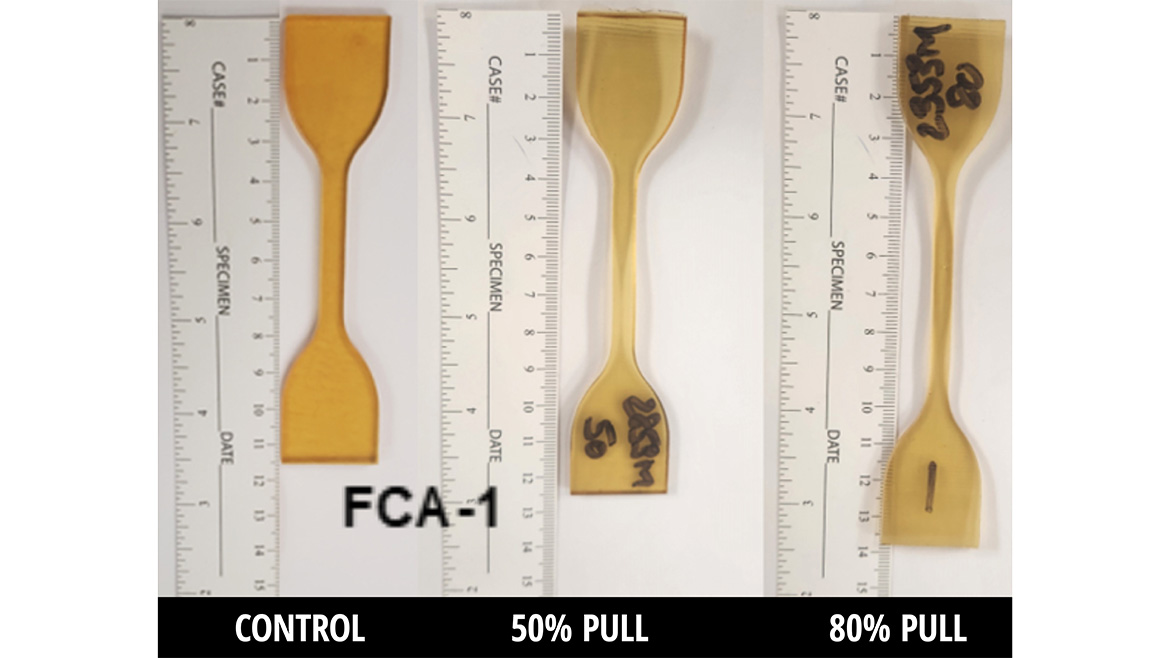
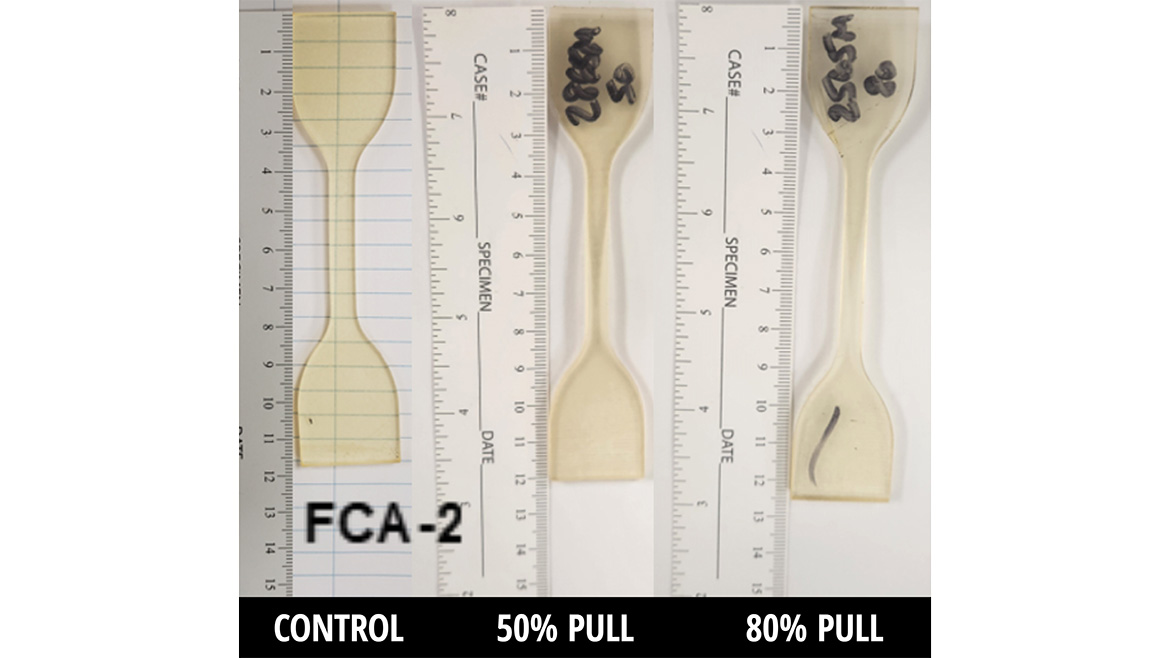
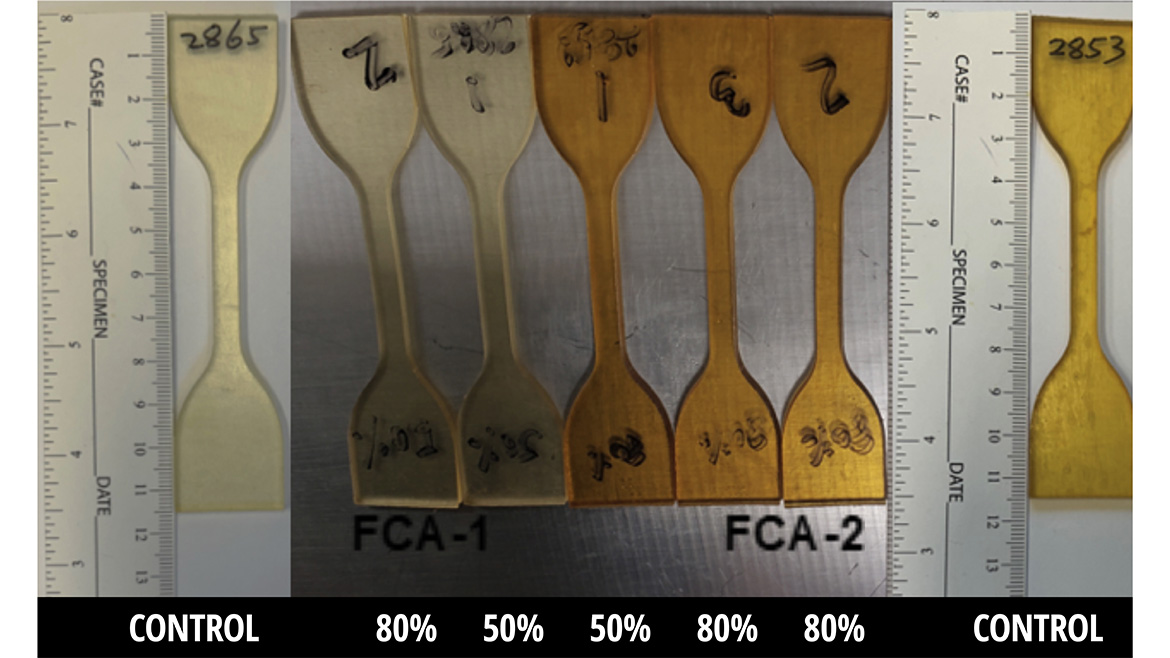
The effect of elevated temperature on the tensile properties was also examined. Control samples were cured at ambient temperature for 7 days. Additional samples underwent further heating at 50 °C or 70 °C for two hours following the seven-day ambient cure. As shown in Table 9, heating at 50 °C or 70 °C did not affect the tensile properties, suggesting that no additional curing occurred at temperatures above ambient.
Effect of Fumed Silica on Cure Speed and Tensile Properties
Flexible epoxy is often used as a concrete joint sealant or crack-bridging material and typically requires a thickening agent. Fumed silica is a common rheology modifier. Both FCA-1 and FCA-2 were formulated with 5% fumed silica (Aerosil E812), and their cure speed and tensile properties were evaluated to assess the effect of fumed silica.
As shown in Table 10, the addition of 5% fumed silica significantly increased the mixed viscosity compared to the control but had minimal impact on cure speed and hardness development. Although fumed silica reduced flexibility, both systems remained flexible enough to pass the -10 °C bend test. The presence of fumed silica only slightly affected the clarity of the 0.5 cm-thick casting. On the positive side, fumed silica enhanced both tensile and tear strength, as demonstrated in Figure 5.
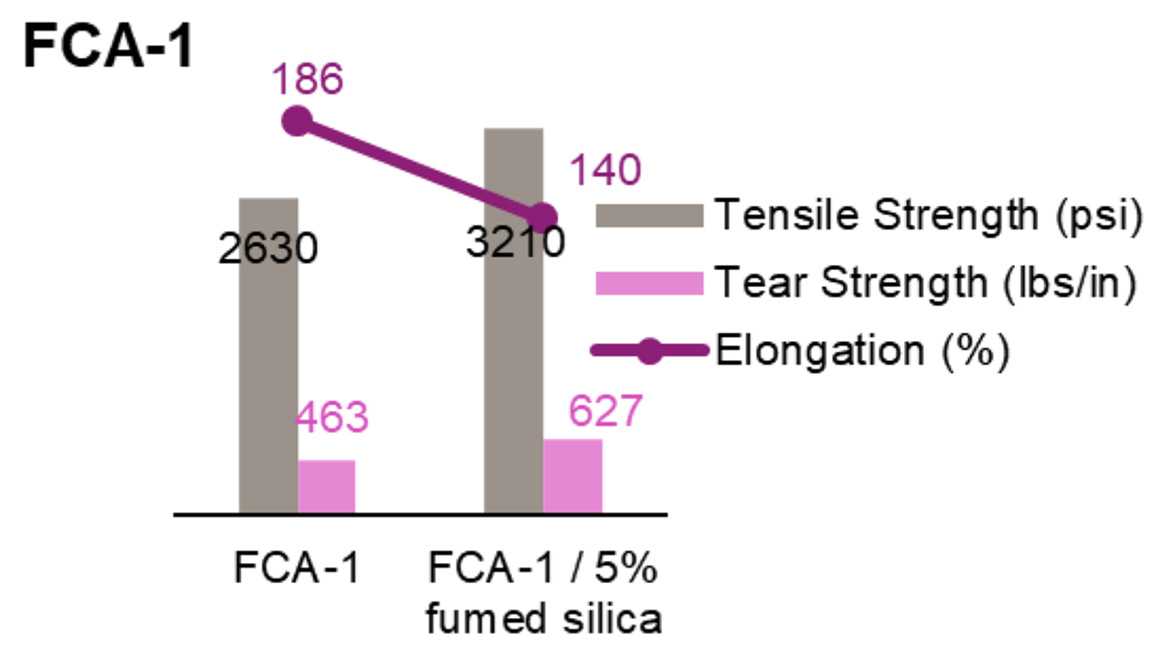

Thermal Properties
For any 2K system, achieving a high degree of reaction is crucial for full property development. In epoxy systems, the degree of reaction can be assessed by differential scanning calorimetry (DSC) to measure the degree of cure. The degree of cure is directly related to the reactivity of the epoxy curing agent system.
The results, summarized in Table 11, show that both systems reached a high degree of cure, exceeding 90% at both ambient and 10 °C conditions. These findings correlate with the tensile properties discussed earlier, where heating at 50 °C and 70 °C did not introduce changes in tensile strength and elongation. Additionally, the glass transition temperature (Tg) was also determined by DSC, revealing that both systems exhibit a Tg around 2 °C, which is below ambient temperature.
Concrete Adhesion and Intercoat Adhesion
High-performance flooring systems often consist of multiple layers tailored to specific end-use requirements. Flexible epoxy is frequently used as a protective layer to accommodate concrete cracks and movement. It can be applied directly onto concrete or onto a thin concrete primer, with a topcoat or midcoat subsequently applied over the flexible epoxy layer. When a flexible epoxy system is used directly on concrete as a primer, ensuring strong adhesion to concrete and intercoat adhesion with the next layer is crucial for the successful installation of a high-performance, multilayer floor.
In fast return-to-service multilayer flooring systems, each layer must cure quickly, particularly the primer, to allow the same crew to apply subsequent layers within the same shift. Additionally, flexible epoxy can also be used as a joint sealant and crack-bridging material, where adhesion to concrete is just as important as in flooring systems.
Concrete adhesion was evaluated using a pull-off test in accordance with ASTM D7234. The concrete blocks used in this study had a concrete surface profile (CSP) of 2 or 3. For tests involving damp concrete, the blocks were submerged in water for 24 hours and then removed before coating. The new flexible epoxies, FCA-1 and FCA-2, were coated at 6 mil wet film thickness (WFT) on dry and damp concrete and cured at 23 °C and 50% RH for 7 days before testing. The results, shown in Figure 6, demonstrate good adhesion on both dry and damp concrete for FCA-1 and FCA-2. The image on the left highlights the bulk concrete failure after the dolly pull.
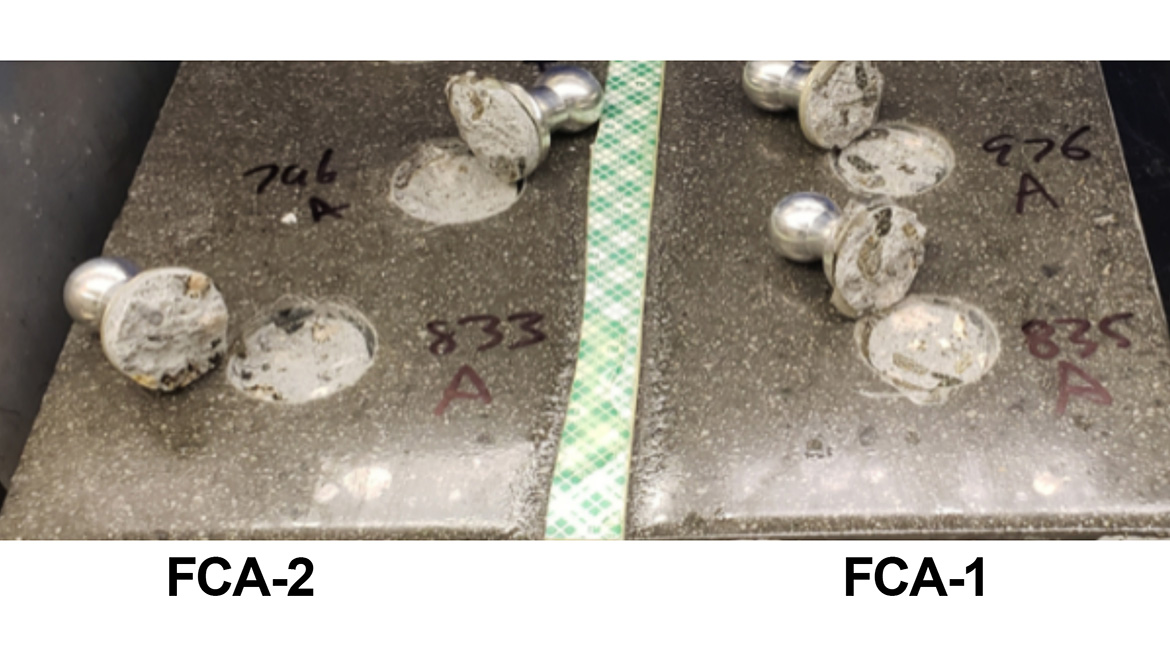
Intercoat adhesion was evaluated using two methods outlined in ASTM D3359: Method A (X-cut) and Method B (Cross-cut). The flexible epoxy was applied as a primer at 6 mil WFT on a cold-rolled steel substrate. After primer curing overnight at 23 °C and 50% RH, two types of topcoats were applied at 10 mil WFT: a standard cycloaliphatic epoxy and an aliphatic polyaspartic (polyurea). The topcoats were allowed to cure for 7 days before testing.
The adhesion test results were rated according to the ASTM standard scale. For the X-cut method, results were rated on a scale of 0A-5A, with 5A indicating no peeling or removal of coatings. For the Cross-cut, the rating ranged from 0B-5B, with 5B showing that the edges of the cuts were completely smooth and none of the squares of the lattice were detached.
The test results, shown in Table 12, demonstrate that both FCA-1 and FCA-2 systems exhibit excellent intercoat adhesion to epoxy and polyurea topcoats. The fast cure and outstanding adhesion to both concrete and subsequent layers make these systems ideal for applications requiring a fast return to service, allowing multiple layers to be applied efficiently to reduce downtime.
Conclusions
Fast return to service, enhanced performance and a better environmental, health and safety (EHS) profile are key drivers for new product innovation in the coatings industry. There is an unmet market need for developing fast-cure, flexible and tough epoxy systems with improved EHS profiles, without using substances of high concern. The newly developed fast and flexible curing agents, FCA-1 and FCA-2, fulfill these unmet needs. They are designed to offer a unique combination of fast cure speed, high elongation, excellent hardness and outstanding strength. These curing agents provide high flexibility with standard diluted liquid epoxy resin without the need for polyurethane modifiers, while also delivering high tensile and tear strength. They are ideal for applications requiring flexibility, toughness and rapid return to service.
Furthermore, FCA-1 and FCA-2 do not contain substances of high concern, such as nonylphenol, making them a prime choice for applications where improved EHS labeling is desired. Additionally, both products utilize a high percentage of bio-based raw materials, resulting in 40% and 20% bio-content in FCA-1 and FCA-2, respectively, enhancing their sustainability and eco-friendliness.
When comparing the two systems, FCA-1 exhibits higher viscosity, darker color and 180% elongation, whereas FCA-2 has lower viscosity, lighter color and 90% elongation. The flexibility and strength can be tailored to specific needs by adjusting the mix ratio of resin and curing agents, providing formulators with a versatile toolbox to meet various application requirements. Both systems demonstrate excellent adhesion to concrete, which is essential for direct concrete applications. Additionally, they offer good intercoat adhesion to epoxy and polyurea, making them an excellent choice in multilayer floor coatings where flexibility is needed to protect from movement and cracks in concrete.
Acknowledgements
The authors would like to thank Mike Oberlander and Dave Brown for their contributions to the experimental work presented in this paper.
References
1 Szycher, M. Szycher’s Handbook of Polyurethanes. CRC Press, New York, 2013, pp. 37-86.
2 Lee, H.; Neville, K. Handbook of Epoxy Resins. McGraw-Hill, Inc., New York, 1967, pp. 5-1–5-18.
3 Tanaka, Y. “Synthesis and Characteristics of Epoxides.” In: May, C. A. (ed.), Epoxy Resins Chemistry and Technology. Marcel Dekker, 1988.
4 FCA-1 and FCA-2: Ancamide 2853 and 2865, Evonik Corporation.
5 Epodil® 748 Reactive Diluent, Evonik Corporation.
6 Cycloaliphatic curing agent: Ancamine 1618, Evonik Corporation.
7 Aliphatic polyurea topcoat: Amicure IC221 with standard HDI trimer.
Looking for a reprint of this article?
From high-res PDFs to custom plaques, order your copy today!








